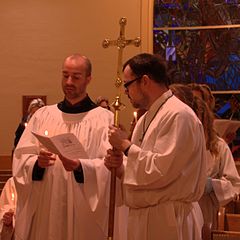* * * *

* * * *
January 31, 2025 – This Sunday, February 2, we remember The Presentation of the Lord; Jesus, presented at the Temple in Jerusalem. There’s more on that later, but first a note on some upcoming posts, up to and possibly into Lent, about a guy some people call Crazy Nick.
In 1967 the Beatles turned themselves into Sgt. Pepper’s Lonely Hearts Club Band. They were tired of being “the Beatles,” so they invented a fictional alter ego to get away from it all. They’d pretend to be someone else, a make-believe band that would allow them to grow, to reinvent themselves and to explore new spiritual horizons. In 1993 I too created a fictional alter ego, as a kind of thought experiment. I created a character I came to call Nick, in honor of Ernest Hemingway’s Nick Adams stories. Like the Beatles’ Sgt. Pepper’s Band, my imaginary “Nick” gave me freedom to explore new horizons, and maybe find some new spiritual insights.
My 1994 novel describing him was a fantasy of sorts. A sports fantasy but also one about reading the Bible to help get good things from God. My imaginary Nick honestly thought he could help his favorite sport teams win. His thought: “Suppose a devout Christian sports fan found a way to work with God to try and help his team win. What lessons would he learn?”
Like Sgt. Pepper’s Band my imaginary Nick gave me the freedom to explore new horizons and find new spiritual insights. One thing I learned in the 30-plus years since that first novel in 1994: There is no magic formula. Nick has suffered heartbreak way more often than not, but there have been successes – detailed in later posts – along with some “aha!” spiritual breakthroughs.
Another thing I learned from Nick: That even if you lose – when your team doesn’t win, or gets embarrassed on the field – the very idea of working with and interacting with the Force that Created the Universe is powerful stuff. (“He’s trying to tell me something!”)
A third thing I learned: Being a good Christian – trying to get good things from God – can be a lot like learning to become a professional poker player. You know you won’t win every hand. No reasonable pro poker player would expect that. But if you learn how to play your cards right, you can expect to make a reasonably comfortable living at it. (And for any Bible-Cons – conservatives, or maybe Modern-Day Pharisees – reading this and getting all upset, let me just add, “That’s a metaphor!” Or maybe an allegory or parable; I get those mixed sometimes.)
I’ll write more on lessons learned from Crazy Nick in the upcoming pre-Lent and Lenten seasons, but meanwhile: Back to The Presentation. It’s part of the season of Epiphanytide, leading up to the Last Sunday after the Epiphany on March 2, and the First Sunday in Lent on March 9.)
Counting forward from December 25 as Day One, we find that Day Forty is February 2. A Jewish woman is in semi-seclusion for 40 days after giving birth to a son, and accordingly it is on February 2 that we celebrate the coming of Mary and Joseph with the infant Jesus to the Temple at Jerusalem…

In other words, the day celebrates an early episode in the life of Jesus, “to officially induct him into Judaism.” (In many churches it’s also called Candlemas, as illustrated at right.) Luke described the episode at 2:22–40: “Mary and Joseph took the Infant Jesus to the Temple in Jerusalem … to complete Mary’s ritual purification after childbirth.”
Luke explicitly says that Joseph and Mary take the option provided for poor people (those who could not afford a lamb) (Leviticus 12:8), sacrificing “a pair of turtledoves, or two young pigeons.” Leviticus 12:1–4 indicates that this event should take place forty days after birth for a male child, hence the Presentation is celebrated forty days after Christmas.
In other words, they were there “in obedience to the Torah (Leviticus 12, Exodus 13:12-15.” (On Purification after Childbirth, “if she cannot afford a lamb, she is to bring two doves or two young pigeons, one for a burnt offering and the other for a sin offering.”)
Other tidbits from past posts: Mary did this even though she’d “borne Christ without incurring impurity” – the usual impurity involved in conception – but “went to the Temple in Jerusalem to fulfill the requirements of the Law of Moses.” (To set a good example, like Jesus insisting that John baptize Him.) Another tidbit: This first Presentation put Jesus on the long road to His second one, at the hands of Pontius Pilate, showing Him to the mob.
A reminder that from the time of His first Presentation – at just over a month old – Jesus’ life was one long journey to that second presentation. (On the eve of making the sacrifice that would literally change history, if not “split history in two.”)
And it all began with “Simeon and Anna recognizing the Lord Jesus.” (Shown below.)
So, what does this have to do with any lessons I might have learned from Crazy Nick? Just that I published my first novel about him in 1994. A year later I published my first book in the Not your daddy’s Bible mode, “Jesus Christ, Public Defender.” (Of which more in future posts.) Years later – in April 2014 – I started this blog, with a series of posts that I’ve left untouched and uncorrected, so you can judge how much I’ve progressed. (If at all. See for example On Jonah and the bra-burners, from 2015.) You might call that a presentation of my own…
* * * *

* * * *
The upper image is courtesy of Sgt Pepper’s Lonely Hearts Club Band Image – Image Results. For the original album cover see Sgt. Pepper’s Lonely Hearts Club Band – Wikipedia.
The Book of Common Prayer reference: The “corporate-mystical” prayer is on page 339, the post-communion prayer for Holy Eucharist, Rite I.
“Feast days” are designated days on the liturgical (church) calendar “set aside to commemorate events, saints, or doctrines that are important in the life of the Church. These can range from Solemnities, which are the highest-ranking feast days like Easter and Christmas, to optional memorials that celebrate lesser-known saints.” Feast Days: Celebrating the Church’s Calendar.
Re: 1994 novel. I did a sequel of sorts, “30 years’ feedback,” in 2024.
Re: Magic formula. Merriam-Webster defines the term as “a simple and sure way to an end.”
Re “powerful stuff.” The reference is to the George Jones lyric in his song White Lightning:
Well a city slicker came and he said I’m tough – I think I want to taste that powerful stuff – He took one slug and he drank it right down I heard him moanin’ as he hit the ground – Mighty mighty pleasin you’r pappy’s corn squeezin…
BTW: That’s another metaphor, like the one about the Poker player.
Re: Today’s Pharisees. See Self-Test: Are You a Modern-Day Pharisee? – Dr. Eitan Bar:
Today, the term “Pharisee” has become synonymous with legalism, judgmentalism, and a condescending attitude toward others. While Phariseeism was once a specific religious movement, its spirit lives on in modern times through people who prioritize rules over relationships, law over love, and condemnation over compassion.
For this post I borrowed from or referred to On the FIRST “Presentation of the Lord,” from 2017. (That post closed with a picture of Donald Trump and this note: “I ran across a Bible passage apropos to current events. The Daily Office Readings for February 1[, 2017] included Isaiah 54:15: ‘If anyone stirs up strife, it is not from me.'” Also, “The LORD is a God of knowledge” – The Presentation, 2019, with a quote from Matthew 5:22, “If you call someone an idiot, you are in danger of being brought before the court. And if you curse someone, you are in danger of the fires of hell.” (From the NLT translation.)) Also from The “Presentation of our Lord” – 2020, On the Presentation of Jesus – 2/2/22, and Jesus “Presented” – 2024.
Re: Other posts on Jonah. See also 2024’s On Bra-burners and the True Test of Faith, and 2020’s Jonah: “Ain’t about no stinkin’ whale!”
About the presumptive audacity of calling this a “presentation of my own,” see 1st Corinthians 11:1, “You are to imitate me, just as I imitate Christ.”
The lower image is courtesy of Simeon And Anna Recognize The Lord Jesus – Image Results. See also Simeon and Anna Recognize the Lord in Jesus – Rembrandt, and the “Simeon” link in the Wikipedia article on the Presentation, or at “Rembrandtonline.” For another interpretation, see “Simeon the Godreceiver by Alexei Egorov. 1830–40s.”
* * * *




